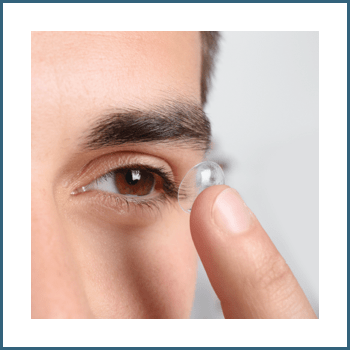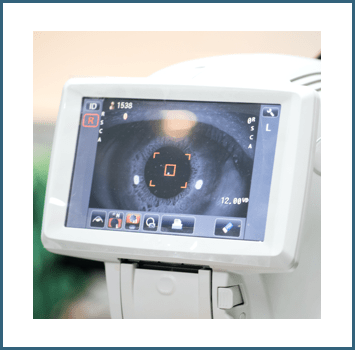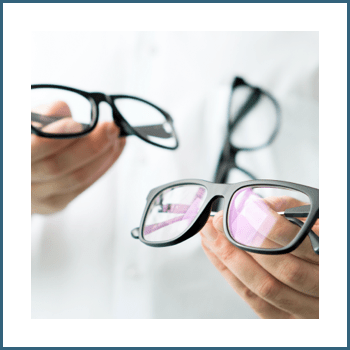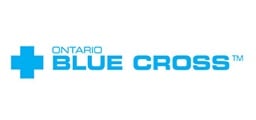Watching Over Children’s Vision
Children are changing and growing all the time, and so is their visual health. A growth spurt can be exciting, but it can also come with changes to eyesight or health. Your child may seem klutzy or prone to falls because of growing limbs, but a vision problem may be the real cause. Vision problems can also impact education, as 80% of school learning is visual.
Children may not tell their parents when they have vision problems; they may not know how to express their difficulties or even think that everyone sees the way they do. Regular appointments with our eye care team can help you watch over changes in your child’s vision and eye health.
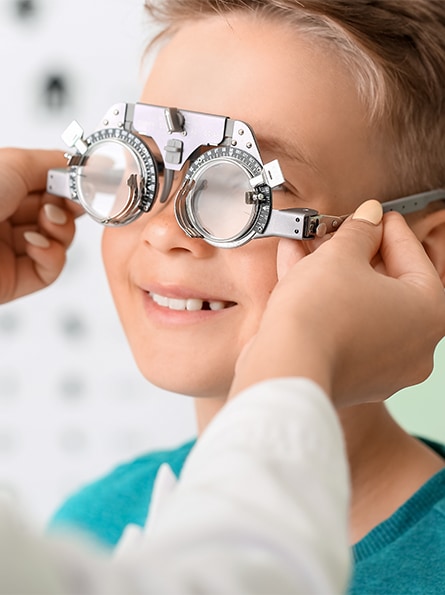

When to Book an Eye Exam for Your Child
How often you should schedule an eye examination for your child can depend on their unique vision needs. For example, if your child has myopia (nearsightedness), they may need to visit more frequently to update their prescription or fit new frames after a growth spurt.
The Ontario Health Insurance Plan (OHIP) covers 1 yearly comprehensive eye examination and minor assessments for children 19 and under. The Canadian Optometry Association’s recommendations for children include:
- A first eye examination between 6–9 months
- At least 1 eye examination between 2–5 years
- Yearly eye examinations after starting school
Why Should You Book an Eye Exam for Your Child?
Regular comprehensive eye examinations can help you safeguard your child’s sight and ocular health. Undiagnosed refractive errors, like myopia (nearsightedness), hyperopia (farsightedness), or astigmatism can create obstacles to learning and skill development. Vision can affect classroom learning and extracurricular activities.
Vision is more than the ability to see objects at a distance. Sight and eye health are essential for developing visual skills, including hand-eye coordination, visual memory, and spatial learning.
Regular children’s eye examinations can help our eye doctors diagnose vision and eye problems early. For example, 51% more children would receive successful treatment for amblyopia (lazy eye) before age 10 if they had regular eye appointments.
By seeing your kids often, we get to know them better! Children can change fast, and so can their eye health. With regular eye assessments, we can recognize minor changes and customize our treatment options for their comfort level.
Signs & Symptoms to Watch for in Children
Your child may not know how to describe their visual experience. They may think the way they see is normal. Knowing common signs and symptoms can help you detect vision changes or eye problems.
Some signs and symptoms your child may exhibit include:
- Disliking near-vision work (reading, Lego, etc.)
- Burning, itchy, or watery eyes
- Closing or covering one eye to see
- Delayed learning of the alphabet
- Difficulty concentrating
- Excessive eye rubbing or blinking
- Eye turn (strabismus) or lazy eye (amblyopia)
- Forgetting what they just read
- Frequent headaches or eye strain
- Head tilting or turning (to look at objects)
- Holding books/objects close to their face
- Losing their place when reading
- Poor hand-eye coordination
- Poor performance in school
- Persistent word or number reversals
- Problems with laterality
- Skipping words or letters when reading/writing
- Squinting to see objects
If you observe any signs or symptoms in your child, or they complain about their sight or eyes, it’s best to contact us for an eye assessment. We can determine if your child needs support for their vision.
Safeguard Your Child’s Sight
Every child has unique eye care needs. Whether they have a million eye questions or need more time to get comfortable during a visit, we can help.
We want your kids to feel comfortable in our office. We’re passionate about vision and eye health, and we want to share that passion by educating our patients.
Regular eye examinations can help safeguard your child’s sight. It’s also an opportunity for them to learn about eye care and maintain life-long healthy vision. Contact us today for a children’s eye appointment. Trust us, you’ll see!

Where To Find Us
At the corner of Springbank Drive and Wonderland Road, our clinic offers plenty of parking out front.

Our Address
- 585 Springbank Dr.
- London, ON N6J1H3
Talk to Us
- Phone: 519-472-0210
- Email: [email protected]
Our Hours
- Monday: 8:00 AM – 7:30 PM
- Tuesday: 8:00 AM – 7:30 PM
- Wednesday: 8:00 AM – 7:30 PM
- Thursday: 8:00 AM – 7:30 PM
- Friday: 8:00 AM – 5:00 PM
- Saturday: Closed
- Sunday: Closed

Frames We Love!




Read Our Blog
Can You Wear Contact Lenses With Dry Eyes?
Contact Lenses, Dry EyeYes, many people with dry eyes can wear contact lenses comfortably with the right strategy and lens choice. […]
How Common is Age-Related Macular Degeneration in Canada?
Eye ConditionAge-related macular degeneration is one of the leading causes of vision loss among Canadians over the age of 50, with more than 2.5 million people affected.
[…]
How Long Does it Take to Adjust to New Eyeglasses?
Frames & LensesYour eyes and brain need time to adapt to your new lenses, and this adjustment period varies from person to person. Some lucky folks feel comfortable within a day or two, while others might need up to two weeks to fully settle in. […]
Can You Wear Contact Lenses With Dry Eyes?

Yes, many people with dry eyes can wear contact lenses comfortably with the right strategy and lens choice. […]
How Common is Age-Related Macular Degeneration in Canada?

Age-related macular degeneration is one of the leading causes of vision loss among Canadians over the age of 50, with more than 2.5 million people affected.
[…]
How Long Does it Take to Adjust to New Eyeglasses?

Your eyes and brain need time to adapt to your new lenses, and this adjustment period varies from person to person. Some lucky folks feel comfortable within a day or two, while others might need up to two weeks to fully settle in. […]



